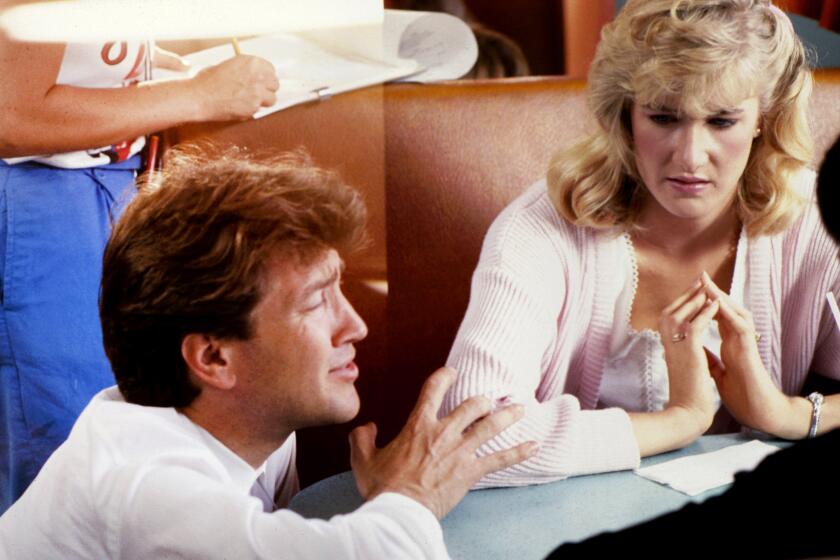‘Flamenco’ Steps Into Pure Grandeur
- Share via
To see “Flamenco” is to be swept up in a performance dream, to experience a vibrant musical tradition as filtered through Spain’s top director and one of the world’s preeminent cinematographers. If you’re not an aficionado when you go, you might be persuaded to become one by the time you leave.
Veteran director Carlos Saura, with more than 30 films to his credit, has dealt expertly with performance before in, among others, “Carmen” and “Blood Wedding.” In “Flamenco,” he has employed an estimated 300 performers--singers, dancers, guitar players, chanters and rhythmic clappers--to take stock of an ageless tradition at this particular time and place.
Flamenco, a brief crawl at the film’s beginning tells us, is a half-a-millennium-old fusion art, a creation of elements of Gypsy, Arabic, Jewish, African and other music that came into its own in Andalucia around 1850. Though the film uses subtitles to identify styles of flamenco like bulerias, guajiras and alegrias, no attempt is made to define or describe the characteristics of each.
Similarly, though the press notes let on that such flamenco luminaries as Paco de Lucia, Manolo Sanlucar and dancer Joaquin Cortes appear in the film, unless you know these folks by sight you won’t figure out who they are. (Cortes, recognizable from Pedro Almodovar’s “The Flower of My Secret” and dancing a fierce bare-chested farruca, is the one exception.)
But though viewers may occasionally entertain the perverse wish that Ed Sullivan was around to say, “Let’s hear it for Paco de Lucia, what a performer,” most of the time not knowing who’s who is an acceptable price for the pleasure of feeling we’ve stumbled onto the flamenco show of a lifetime. Though obviously carefully planned, “Flamenco” creates the illusion of unfolding spontaneously, a found event not a planned extravaganza. Information can be gotten later; for now, we’re happy to let the music flow.
None of this would work well without the expressive work of director of photography Vittorio Storaro. A three-time Oscar winner for cinematography (“Apocalypse Now,” “Reds,” “The Last Emperor”), Storaro makes even standard shots come off as elegant and involving. A key player in the film’s visual invention, its use of single-color backgrounds and the way it blends light, dark and shadow, Storaro demonstrates that you can be a genius even photographing an empty stage.
Both director and cinematographer must share a fascination with faces, because everyone who appears on camera in “Flamenco” has a keenly expressive one. Or it could be that involvement with this intense, passionate music makes deep character lines inevitable.
Several different styles of flamenco dance are on display, executed by some of the youngest and oldest performers in the film, the physical energy of the former contrasting with the sense of dignity of the latter. It’s quite a combination.
It is the unmistakable sound of flamenco singing, however, that is the most haunting of this film’s experiences. With voices that verge on shouts of pain and songs that seem to leave the singers continually on the edge of tears, this is a sound that intoxicates.
“Flamenco” also demonstrates how exciting it can be to perform in an art form that venerates tradition while valuing personal expression. The words on the film’s Spanish CD package say it succinctly: “Ritmo, Pasion, Fuerza y . . . arte, much arte.” Rhythm, passion, strength and art, much art.
*
* Unrated. Times guidelines: nothing but singing and dancing.
‘Flamenco’
Starring Paco de Lucia, Manolo Sanlucar, Lole y Manuel, Joaquin Cortes, Farruco, Farruqito, Mario Maya, Matilde Coral, Enrique Morente, Jose Merce, Merche Esmeralda, Manuela Carrasco, La Paquera de Jerez, Carmen Linares, Paco Toronjo, Fernanda de Utrera, Chocolate, Paco del Gastor.
Released by New Yorker Films. Director Carlos Saura. Producer Juan Lebron. Executive producer Jose Lopez Rodero. Cinematographer Vittorio Storaro. Editor Pablo del Arno. Costumes Rafael Palermo. Musical producer and director Isidro Mun~oz. Production design Jose Lopez, Carlos Regido. Art director Rafael Palermo. Sound Chris Munro, Jesus Bola, Gerry Humphryes, Andrew Glen. Running time: 1 hour, 40 minutes.
* Nuart, 11272 Santa Monica Blvd., West Los Angeles, (310) 478-6379.
More to Read
Only good movies
Get the Indie Focus newsletter, Mark Olsen's weekly guide to the world of cinema.
You may occasionally receive promotional content from the Los Angeles Times.











